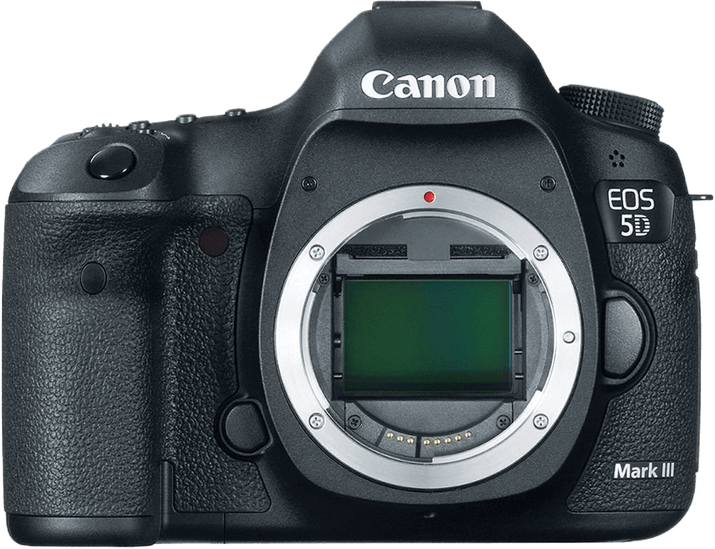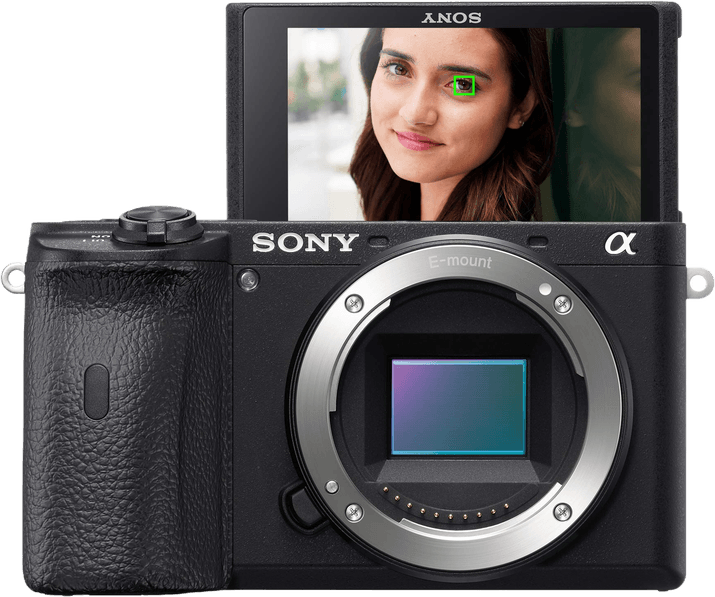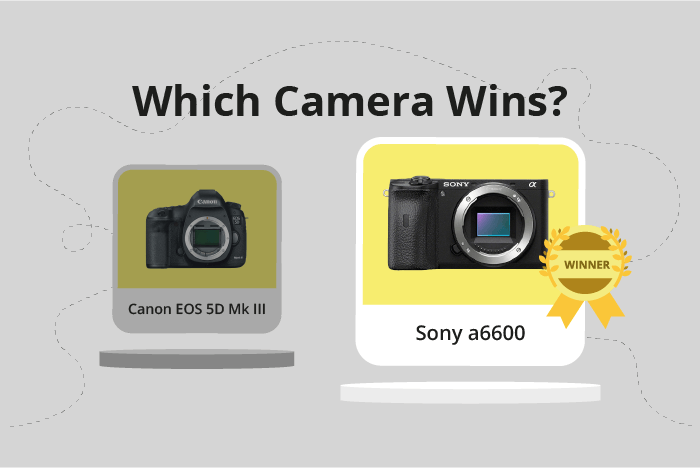Canon EOS 5D Mark III vs Sony a6600 Comparison
Canon EOS 5D Mark III

Sony a6600

The Sony a6600 outperforms the Canon EOS 5D Mark III with a score of 75/100 compared to the latter’s 65/100. Both cameras share some common specifications, including their release year and launch price. However, the Sony a6600, a mirrorless camera, has several advantages over the Canon EOS 5D Mark III, a DSLR camera.
The Sony a6600 is considerably lighter and more compact, weighing only 503g and measuring 120 x 67 x 69mm, while the Canon EOS 5D Mark III weighs 950g and measures 152 x 116 x 76mm. This makes the Sony a6600 more portable and easier to handle. Additionally, the Sony a6600’s higher score signifies its superior overall performance and features.
On the other hand, the Canon EOS 5D Mark III still has its merits, such as its sturdy build and well-established reputation in the photography community. However, the Sony a6600’s advantages in weight, size, and performance make it the better choice for most photographers.
Canon EOS 5D Mark III vs Sony a6600 Overview and Optics
The Sony a6600 outperforms the Canon EOS 5D Mark III in optics, with a score of 76/100 compared to the Canon’s 67/100. Both cameras share some common specifications, such as having a CMOS sensor and a similar DXOMARK score for the sensor (82 for the Sony and 81 for the Canon). However, there are notable differences that make the Sony a6600 a superior choice in terms of optics.
The Sony a6600 has a higher megapixel count at 24.2, compared to the Canon’s 22.3, resulting in better image resolution. Additionally, the Sony a6600 boasts a faster shooting speed of 11 frames per second, doubling the Canon’s 6 frames per second. This allows for capturing more detailed and dynamic action shots. The Sony a6600 also has image stabilization, which is absent in the Canon EOS 5D Mark III. This feature helps reduce camera shake and improves image quality in various shooting conditions.
On the other hand, the Canon EOS 5D Mark III has a full-frame sensor, which provides a larger sensor size than the Sony a6600’s APS-C sensor. This translates to better low-light performance and a shallower depth of field. The Canon also has an EF lens mount, which offers a wider range of lens options compared to the Sony E mount.
Despite its advantages, the Canon EOS 5D Mark III falls short when compared to the Sony a6600’s overall optical performance. The Sony a6600’s higher megapixel count, faster shooting speed, and image stabilization make it the better choice for most photographers. While the Canon EOS 5D Mark III has its merits, such as a full-frame sensor and a wider range of lens options, these factors are not enough to surpass the Sony a6600’s superior optics.
Canon EOS 5D Mark III vs Sony a6600 Video Performance
The Sony a6600 outperforms the Canon EOS 5D Mark III in video capabilities, with a video score of 91/100 compared to the Canon’s 56/100. Both cameras share some common specifications, such as having a max video frame rate of 60fps. However, the Sony a6600 surpasses the Canon EOS 5D Mark III in several aspects, making it the superior option for video.
The most significant advantage of the Sony a6600 is its 4K video resolution, offering video dimensions of 3840 x 2160. In contrast, the Canon EOS 5D Mark III has a lower max video resolution of Full HD, resulting in video dimensions of 1920 x 1080. This difference allows the Sony a6600 to produce higher quality videos with more detail.
Another notable feature of the Sony a6600 is its time-lapse functionality. This built-in feature enables users to create stunning time-lapse videos without the need for additional equipment or software. The Canon EOS 5D Mark III does not have this capability.
Despite its lower video score, the Canon EOS 5D Mark III still offers reliable video performance with its Full HD resolution and 60fps max video frame rate. For users primarily focused on photography, this camera may still be a suitable choice. However, for those prioritizing video capabilities, the Sony a6600 is the clear winner.
Considering the differences in video features and performance, the Sony a6600 is the superior choice for videographers and those seeking advanced video capabilities. The Canon EOS 5D Mark III, while still a reliable camera, falls behind in this aspect and may be more suitable for users prioritizing photography.
Canon EOS 5D Mark III vs Sony a6600 Features and Benefits
The Sony a6600 emerges as the winner in the features department with a score of 81/100, while the Canon EOS 5D Mark III trails behind with a score of 59/100. Both cameras share some specifications, such as a lack of GPS and screen sizes of 3 inches or more, with the Canon 5D Mark III having a slightly larger screen at 3.2 inches.
The Sony a6600 outshines the Canon 5D Mark III in several aspects. The a6600 has a touchscreen, making it easier to navigate menus and change settings quickly. Additionally, it boasts a flip screen, allowing users to take photos and videos from a variety of angles easily. The a6600 also supports WIFI and Bluetooth connectivity, enabling seamless transfer of files and remote control of the camera using a smartphone or other compatible devices.
On the other hand, the Canon 5D Mark III has a higher screen resolution of 1,040,000 dots compared to the a6600’s 921,600 dots, providing a sharper and clearer image display. However, it lacks the convenience of a touchscreen, flip screen, and wireless connectivity found in the Sony a6600.
Considering these points, the Sony a6600 proves to be the superior choice in terms of features, offering a touchscreen, flip screen, and wireless connectivity that enhance user experience and convenience. The Canon 5D Mark III, while offering a higher screen resolution, falls short in other essential aspects, making the a6600 a more versatile and user-friendly option for photographers and videographers.
Canon EOS 5D Mark III vs Sony a6600 Storage and Battery
The Canon EOS 5D Mark III outperforms the Sony a6600 in storage and battery with a score of 76 points, compared to the Sony’s 48 points. Both cameras are compatible with SD, SDHC, and SDXC memory cards, but the Canon 5D Mark III has two memory card slots and accepts Compact Flash and UDMA cards, while the Sony a6600 has only one slot and accepts Memory Stick Pro Duo cards. This gives the Canon 5D Mark III an advantage in storage flexibility.
In terms of battery life, the Canon 5D Mark III lasts for 950 shots with its LP-E6 battery, while the Sony a6600 can take 810 shots with its NP-FZ100 battery. This difference in battery life makes the Canon 5D Mark III more reliable for longer shooting sessions. However, the Sony a6600 has the advantage of USB charging, making it more convenient to charge on the go.
To sum up, the Canon 5D Mark III excels in storage capacity and battery life, making it better suited for extended use and versatile storage options. The Sony a6600, on the other hand, offers the convenience of USB charging, which can be beneficial for travelers and those who need to recharge their camera easily.
Canon EOS 5D Mark III vs Sony a6600 – Our Verdict
Are you still undecided about which camera is right for you? Have a look at these popular comparisons that feature the Canon EOS 5D Mark III or the Sony a6600:

